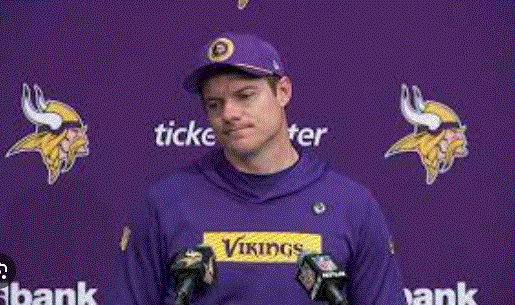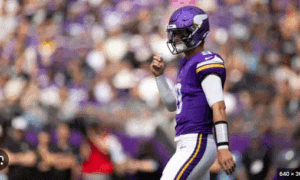
The Minnesota Vikings and the Quarterback Conundrum: J.J. McCarthy’s Turn in the Spotlight
Over the past decade, the Minnesota Vikings have rarely enjoyed stability at the quarterback position. While they’ve had some standout performances from various signal-callers, a long-term, undisputed franchise quarterback has eluded them. From veteran stopgaps to first-round hopefuls, the Vikings’ quarterback room has often been defined more by speculation and scrutiny than consistent success. The latest name to step into the spotlight is J.J. McCarthy, a young talent who, despite his potential, has already faced a barrage of questions before even taking his first snap as a full-time starter.
A History of Quarterback Questions in Minnesota
To understand McCarthy’s current position within the franchise, it’s essential to reflect on the Vikings’ recent quarterback timeline. The last ten years have seen the team invest heavily in the position, yet often come up short when it mattered most. Perhaps the most prominent figure in this period was Kirk Cousins, who arrived in 2018 as a high-profile free agent expected to elevate the team into consistent playoff contention.
Cousins, however, proved to be a polarizing figure. His statistics were impressive, often ranking near the top in completion percentage, passing yards, and touchdown-to-interception ratio. Yet, despite individual production, questions loomed about his ability to lead the team in high-pressure, postseason scenarios. Critics pointed to his win-loss record in primetime and playoff games, arguing that while Cousins was solid, he was never truly elite.
That perception persisted throughout his tenure in Minnesota, and while Cousins helped the team remain competitive, he never quite fulfilled the lofty expectations set when he was signed to a fully guaranteed contract. By the end of his run with the Vikings, there was a growing consensus that the team needed to pivot toward a new era under center.
The Sam Darnold Experiment (or Lack Thereof)
In the immediate aftermath of Cousins’ departure, the Vikings were linked to several potential replacements. One of the names that surfaced was Sam Darnold, a former No. 3 overall pick whose NFL journey has been defined by unfulfilled potential. Originally drafted by the New York Jets, Darnold showed flashes of brilliance but was hampered by poor coaching, injuries, and a lackluster supporting cast.
A move to the Carolina Panthers followed, but the results remained inconsistent. Still, his youth and experience made him a candidate for a reclamation project. However, the idea that Darnold could be a long-term answer in Minnesota was met with skepticism—and rightly so. It never materialized into a serious option, and the Vikings made it clear they were aiming higher.
Enter J.J. McCarthy: Promise Meets Pressure
The Vikings’ decision to invest in J.J. McCarthy signaled a clear shift toward the future. A standout at the University of Michigan, McCarthy was known for his leadership, poise, and ability to execute in a pro-style offense. He guided the Wolverines to multiple College Football Playoff appearances and earned praise for his work ethic and football IQ.

However, McCarthy’s transition to the NFL has not been without challenges. Chief among them is a meniscus injury that sidelined him for much of his rookie campaign. While not career-threatening, the injury disrupted his development at a crucial time. Instead of gaining valuable reps, he spent the season focused on rehabilitation, working apart from the team in a tailored recovery program.
That absence raised questions among analysts and fans alike. Would he be ready to step into a leadership role? Could he physically hold up over the course of a 17-game NFL season? Was he mature enough to lead a team with playoff aspirations?
External Speculation: Rodgers Rumors and Beyond
Fueling the uncertainty was the Vikings’ rumored interest in Aaron Rodgers. The longtime Green Bay Packers quarterback, and future Hall of Famer, reportedly had exploratory conversations with the Vikings before ultimately choosing the New York Jets. Even the mere flirtation with Rodgers suggested that the organization wasn’t fully sold on handing the reins to McCarthy just yet.
Such speculation isn’t unusual in the NFL, where teams are always looking to improve at the game’s most important position. However, the optics were not ideal for McCarthy. The whispers of Rodgers-to-Minnesota added to the perception that the Vikings were hedging their bets, uncertain if the young quarterback was ready for prime time.
Kevin O’Connell’s Diplomacy Turns to Clarity
Throughout this quarterback transition, head coach Kevin O’Connell maintained a diplomatic stance. Publicly, he expressed support for all quarterbacks on the roster. He talked about competition, development, and depth—buzzwords that often indicate uncertainty. His comments, while lengthy and measured, didn’t provide much clarity on who would ultimately lead the offense.
That changed on Monday, April 21, at the outset of the team’s 2025 offseason program. Speaking to reporters, O’Connell provided a much more definitive statement on McCarthy’s status.
“He’s full-go. No limitations,” O’Connell said, per Alec Lewis of The Athletic.
It was a straightforward confirmation that McCarthy, now entering his second NFL season, would be an active and fully integrated participant in offseason activities. These initial stages—primarily focused on classroom learning and weight training—might not be flashy, but they’re critical for building leadership and trust within the team.
McCarthy’s Path to QB1 Is Clear
With his health no longer in question and no legitimate competition in the quarterback room, McCarthy appears poised to take over as the Vikings’ starting quarterback. The only other quarterback currently on the roster is Brett Rypien, a journeyman with limited starting experience and little upside beyond being a spot starter or injury replacement.
Although Minnesota is still expected to sign a veteran backup, that player would likely serve as a mentor rather than a challenger. The free-agent market has thinned considerably, and few available quarterbacks have the pedigree to truly push McCarthy for the starting job.
This reality gives McCarthy a rare advantage: a clear runway to develop, without the looming presence of an established veteran breathing down his neck. While the pressure to perform remains, the support from the coaching staff and front office gives him room to grow.
Why McCarthy’s Development Matters So Much
The stakes for McCarthy’s success are incredibly high. Minnesota is a team with playoff aspirations. Their 14-win season not long ago set a new bar for what’s possible. They boast a talented core that includes offensive weapons like Justin Jefferson, a top-five wide receiver in the league, and a solid offensive line. Their defense has made strides, and the coaching staff is widely respected.
In short, the window to contend is open—but only if the quarterback play holds up.
McCarthy doesn’t need to be a superstar right away. What the Vikings need is competent, consistent quarterback play that allows their playmakers to shine. If McCarthy can manage the offense, avoid turnovers, and show growth throughout the season, that might be enough to secure both his job and Minnesota’s place in the playoff hunt.
Ongoing Roster Construction: A Supportive Environment
As the 2025 NFL Draft approaches, the Vikings are expected to prioritize surrounding McCarthy with even more talent. While the roster already includes high-end pieces, there are still areas where depth is lacking.
For example, the team could look to add another wide receiver to complement Jefferson and give McCarthy a reliable outlet. Upgrades at tight end or running back could also help take pressure off the young quarterback.
The offensive line, while solid, may need reinforcements to ensure McCarthy stays upright. A rookie quarterback’s best friend is time in the pocket, and the Vikings will likely continue investing in protection.
On defense, improvements in the secondary and linebacker corps could help the team maintain favorable field position and avoid shootouts—creating more manageable situations for a developing quarterback.
Leadership and Culture: The Intangibles of Success
Perhaps the most encouraging sign for McCarthy is the supportive culture that exists within the Vikings’ organization. Head coach Kevin O’Connell has built a team-first atmosphere that emphasizes accountability, communication, and resilience. Veterans on both sides of the ball have bought into the system, and there’s a clear understanding that everyone has a role to play in the team’s success.
In such an environment, a young quarterback can thrive. Mistakes will happen—especially early—but McCarthy won’t be thrown to the wolves. The coaching staff’s commitment to his development suggests a long-term vision, rather than a short-term panic response.
What Success Looks Like in Year Two
If everything goes according to plan, McCarthy’s second season in the NFL could resemble that of other young quarterbacks who found their footing after a redshirt rookie year. Think of Patrick Mahomes, who sat behind Alex Smith before taking over and exploding onto the scene, or Jordan Love, who benefited from sitting behind Aaron Rodgers before stepping in and finding success in Green Bay.
While no one is expecting Mahomes-level production from McCarthy right away, the template is clear: a year of learning, followed by a year of action and evaluation.
Success in 2025 for McCarthy won’t necessarily be measured by Pro Bowl selections or 4,000-yard passing campaigns. Instead, it’ll be about commanding the huddle, making smart decisions, and gaining the trust of his teammates. If he can do that while keeping the Vikings in the playoff conversation, he’ll have validated the organization’s faith in him.
Leave a Reply